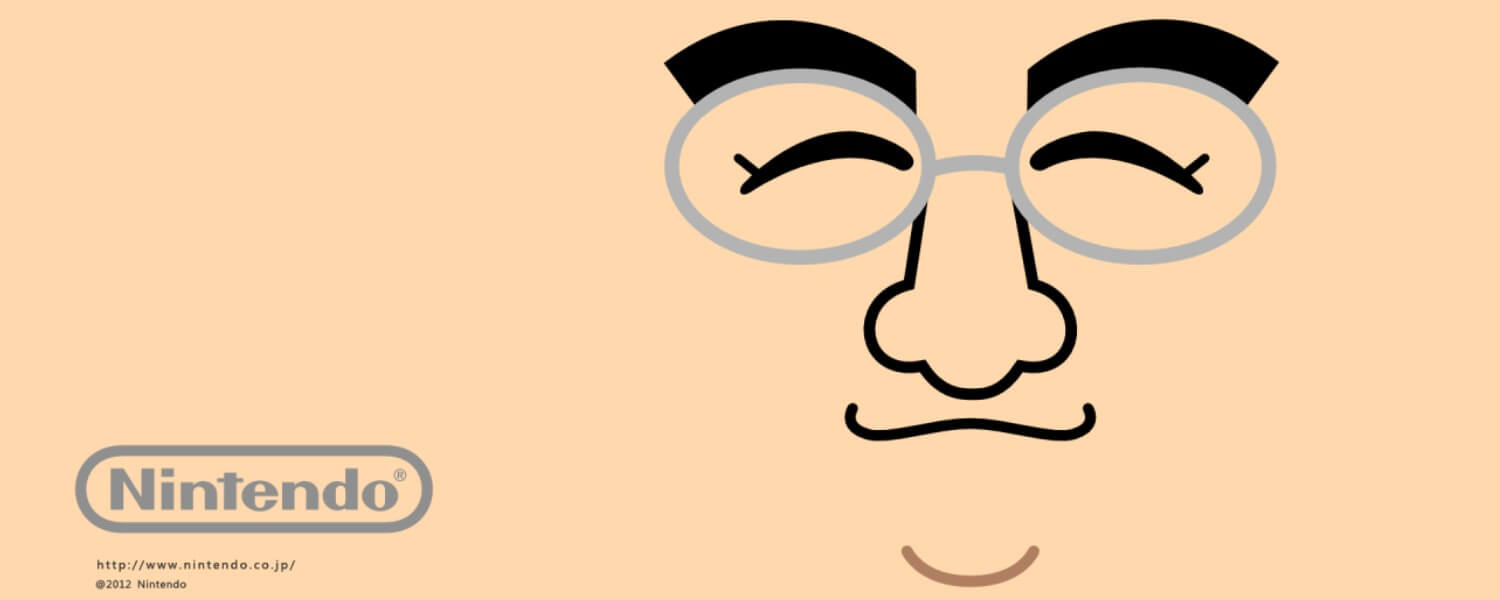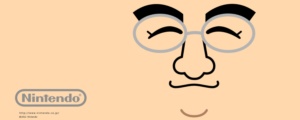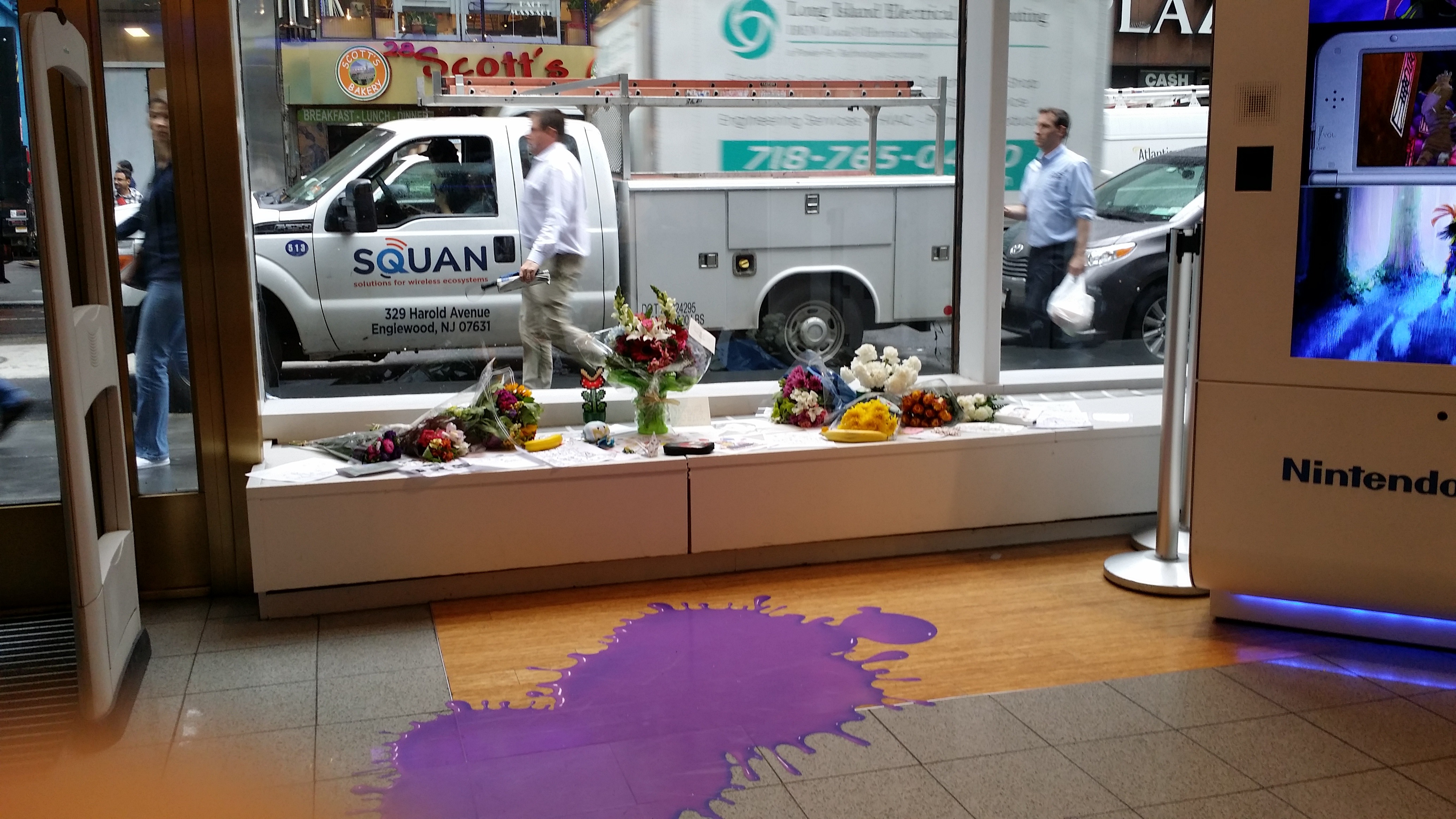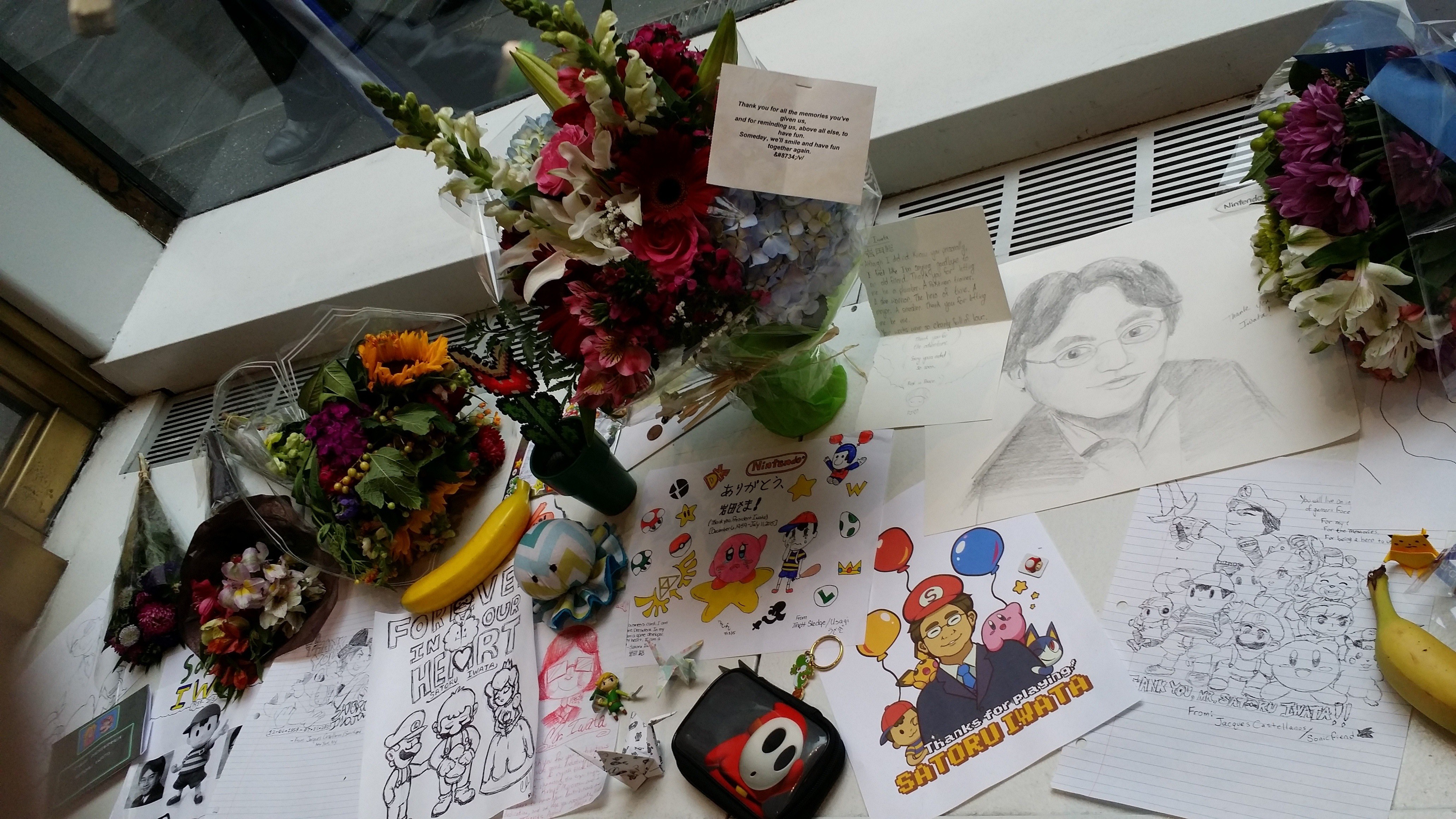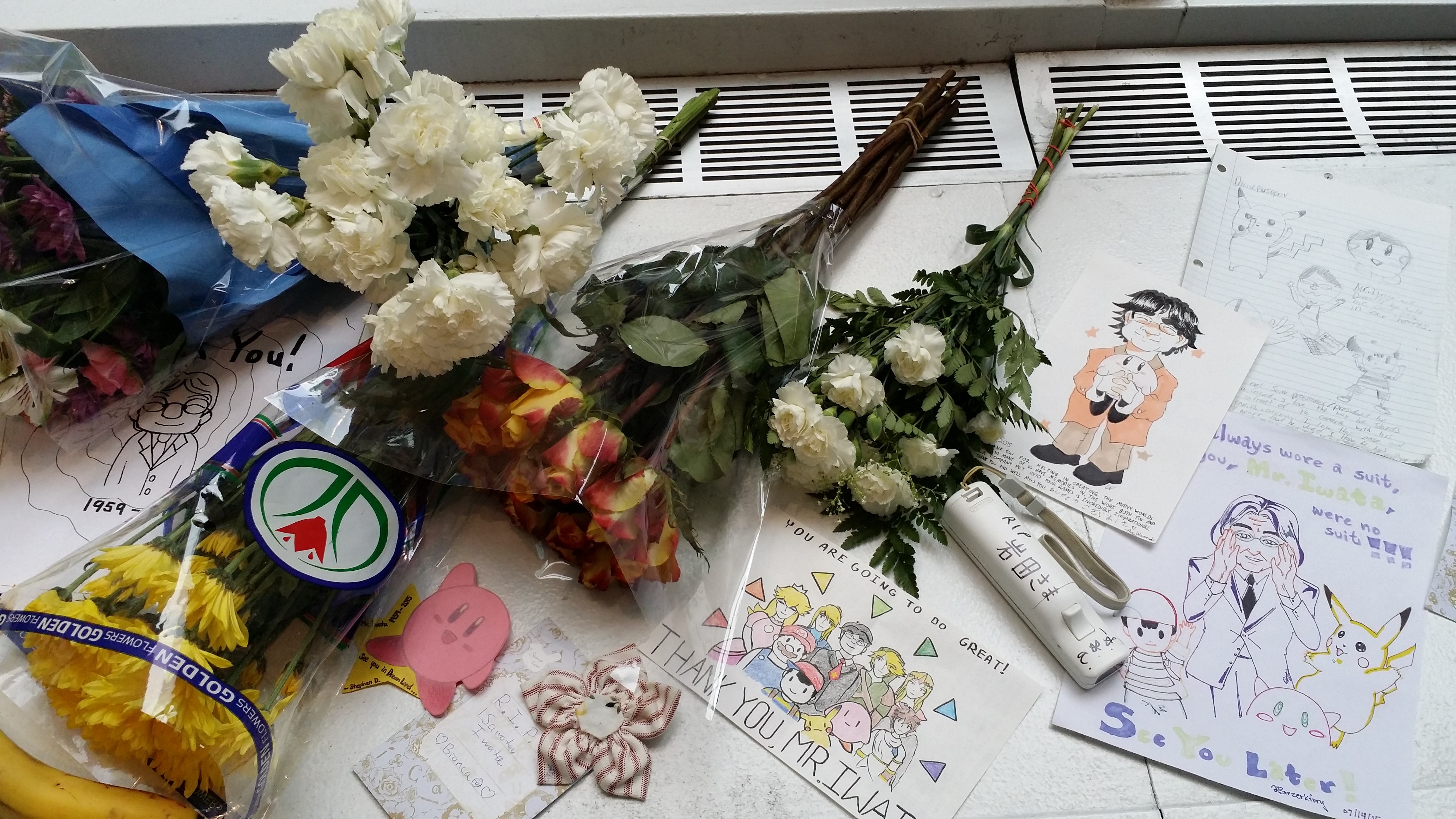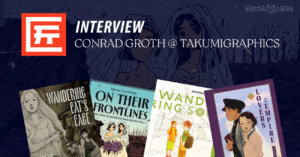It’s been just over a week since we reported on the death of Satoru Iwata. Since then, many fans have given their condolences through words, art, and special actions. Last Wednesday, I went to Nintendo World to write my own message for Iwata-san, the same day that Kotaku visited. The trip there left me in a ponderous mood, and I thought about how Satoru Iwata had changed my life and those of many gamers.
Early Knowledge
My relationship with Nintendo began just like many other video game fans: one console and one game. For me, the console was the Gameboy Color and the game was Pokémon Red. I received these two things along with my sister, her game being Pokémon Blue. Playing that game for the first time was a life changing experience: never before had I felt so immersed in a world of someone else’s imagination and creation. The locales, the music, the journey written out: all of those things remain salient in my memory. It was this visceral introduction that not only began my enjoyment of video games, but my affinity for Nintendo, in particular.
The memory I have of the news that Satoru Iwata had been appointed president is somewhat vague. It was during the time that I subscribed to Nintendo Power, the now-defunct official magazine of the company. It’s possible that I read about it in one of their issues, or that my mother had read about it in the newspaper and mentioned the it to me. At the time I didn’t quite know what this change meant: should I be happy? Weary? Indifferent? “Unsure” wound up being my choice. For a while after the change in command, nothing really seemed different to me.
Clear Connection
The first time I noticed his name was when I bought Animal Crossing for the Nintendo Gamecube. In order to view the credits, you have to visit K.K. Slider (とたけけ Totakeke) on Saturday evening and have him play a song. The last name to appear in those credits is Satoru Iwata’s for being the executive producer.
Animal Crossing was one of my favorite games for the Gamecube, and since then it has become one of my favorite series. From a simple concept came a game that exuded the things in life that are treasured: moments of tranquility, humor even when things aren’t so great (bee stings, man…), helping others, and trying to make the place you live better every time you interact with it. The first Animal Crossing game is known for having playable NES games. I had collected quite a few, one of which was Balloon Fight. Only after his death did I come to learn that Iwata-san was the programmer behind that game.
Revolution and Beyond
My first true impression of Satoru Iwata came when Nintendo was developing the console that would succeed the Gamecube. It was an exciting time for me, since I had never really experienced the change from one home console to another. I remember being elated every month Nintendo Power was delivered during that time. My brother and I would marvel at the pictures and soak in the new information coming out: the console would be called the Revolution; there would be motion controls; it would come out in various colors. We were so excited for it’s release. To us, it was the coolest console coming out, and it was one we would likely be able to afford.
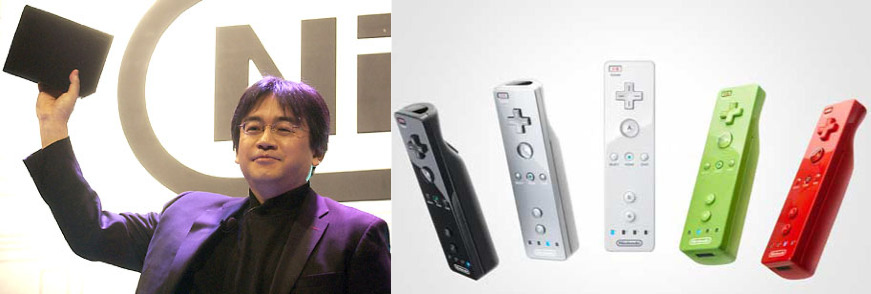 As development continued on the system, though, a number of things changed: the design of the controller was altered slightly, the system would only come in white, and, perhaps the most argued over change, the system was to be called the Wii. My brother and I suffered much disappointment; we had thought the colors were awesome, and the name Revolution was beyond cool. Why on earth would they change it? One of the reasons for the name change was that Wii sounded like “we” and that the two “i” characters represented not only the controls for the system, but two people playing together. While Wii may not sound as cool or as groundbreaking as Revolution, but what it symbolized was more inclusive. Iwata-san led the company down that path of increased inclusiveness, working hard to make a system, as well as games, that everyone could enjoy, no matter the amount of game experience. This decision wound up being quite fruitful, with the console being a best-seller. Despite the changes, I still purchased the system as soon as I could. I can certainly attest to its success at include traditionally non-gamers: my aunt even owns a Wii and turns it on at every family get-together.
As development continued on the system, though, a number of things changed: the design of the controller was altered slightly, the system would only come in white, and, perhaps the most argued over change, the system was to be called the Wii. My brother and I suffered much disappointment; we had thought the colors were awesome, and the name Revolution was beyond cool. Why on earth would they change it? One of the reasons for the name change was that Wii sounded like “we” and that the two “i” characters represented not only the controls for the system, but two people playing together. While Wii may not sound as cool or as groundbreaking as Revolution, but what it symbolized was more inclusive. Iwata-san led the company down that path of increased inclusiveness, working hard to make a system, as well as games, that everyone could enjoy, no matter the amount of game experience. This decision wound up being quite fruitful, with the console being a best-seller. Despite the changes, I still purchased the system as soon as I could. I can certainly attest to its success at include traditionally non-gamers: my aunt even owns a Wii and turns it on at every family get-together.
Nintendo World – Messages and a Memorial
I arrived at Nintendo World at around 1:00 PM. Unlike the reporter for Kotaku, when I came upon the building, there was no one waiting in a line outside. Perhaps the amiibo promotion had been in the morning; if it was later, the line would have still been there. Luckily for me, I could go straight in without worrying about the horde of consumers.
The first thing I noticed was the memorial; I had seen it through the window before I even entered. There so many things left there in remembrance: flowers, pictures, even just little hand-written notes. Looking them over, it was touching to know that people had not only taken their time to make these or spent money to purchase some items, but to also come to Nintendo World to create this small space just for him. As I stood there, a man came over with his child and asked him if he knew why all of these things were here. Even in death, Iwata-san was able to bring people closer together.
After looking at the memorial, I went over to the table with Iwata-san’s photograph. Three notebooks were there for people to write messages. It was the first thing people could see when walking in to the building, and I was quite happy that it wasn’t delegated to a corner of the store. Teen boys, an older woman, and a child were signing the books while I stood in line. Soon enough, I approached one of the notebooks and wrote my small message.
 Afterwards, I wandered upstairs. People were playing game demos and looking at the display cases, as well as deciding on what items they might want to purchase. After perusing the area, I decided to pick up a copy of Splatoon. I know my brother was interested in it, and I thought we could play it together. As I stood in line for the register, I saw 花札 (はなふだ hanafuda) cards on a shelf. I decided to buy those, too. I left the store with two items: one from Nintendo’s past and one from Nintendo’s present.
Afterwards, I wandered upstairs. People were playing game demos and looking at the display cases, as well as deciding on what items they might want to purchase. After perusing the area, I decided to pick up a copy of Splatoon. I know my brother was interested in it, and I thought we could play it together. As I stood in line for the register, I saw 花札 (はなふだ hanafuda) cards on a shelf. I decided to buy those, too. I left the store with two items: one from Nintendo’s past and one from Nintendo’s present.
Final Goodbye
Satoru Iwata’s funeral has now come and gone. On Friday, Genyo Takedo gave a eulogy stating that both he and Miyamoto would do their best to continue Iwata-san’s legacy. As reported by the Wall Street Journal, “Mr. Takeda said the seeds that Mr. Iwata planted would one day grow into flowers ‘that will make people around the world smile.'” Yuji Naka, one of the creators of the iconic character Sonic the Hedgehog, was also in attendance. He posted a photo from the funeral on his Facebook with a short message:
//
His message roughly translates to “Today’s Kyoto has more rain falling than yesterday’s. It seems like Kyoto’s sky is crying, too.”
Yasuyuki Honne, a designer who’s worked on games such as Chrono Trigger, Xenogears, and the two Baten Kaitos games, was also in attendance. He tweeted this message:
岩田さんのお通夜に参列。感謝とお悔やみを。宮本さんが目を真っ赤に腫らしていました。京都も大雨です。 pic.twitter.com/lV6apFr5LD
— 本根 康之 (@honnesan) July 16, 2015
The message can roughly be translated as: “Attending Iwata-san’s wake. To give thanks and condolences. Miyamoto-san’s eyes have swelled a deep red. Kyoto also has heavy rain.”
When I decided to finally sit down and write all of this out, I looked up a list of games that Satoru Iwata worked on. When I found one and looked at its contents, I saw that he received a special thanks in the U.S. credits for the games Pokémon Red and Pokémon Blue. And so I give a special thanks to you, Iwata-san: for unknowingly shaping my perspective as a child, and for being a positive guide for me today. Keep smiling.

Featured Sponsor - JAST
The sweetest romance and the darkest corruption, the biggest titles and the indie darlings; for visual novels and eroge, there's nowhere better.
Big thank you to our supporters
From their continous support, we are able to pay our team for their time and hard work on the site.
We have a Thank-You page dedicated to those who help us continue the work that we’ve been doing.
See our thank you page